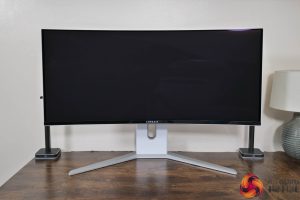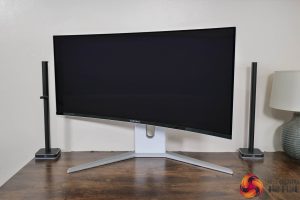I was pleasantly surprised by Corsair's design choices when I first saw the 34WQHD240-C back at Computex 2024. It's definitely an evolution of the 27QHD240 we looked at last year, but it definitely feels more refined this time around. A lot of that comes down the decision to opt for a white and silver colourway, something that gives the screen a very clean look. It may not be for everyone, but it's certainly a welcome change from the bevy of all-black monitors we are used to seeing.
The only thing I'm not too keen on is the chin of the display is made from glossy plastic which catches dust and fingerprints like nobody's business. I would have preferred a matte finish here, but otherwise I like the overall aesthetic. We can also confirm the curvature of the panel – it's 1800R, so a fairly relaxed curve, unlike some of the 800R WOLED screens on the market right now.
You will have noticed Corsair is continuing to use a chunky plastic stand with its displays, and this one offers up to 100mm height adjustment, 30 degrees of swivel both left and right, and then tilt from 7 degrees downwards to 15 degrees upwards.
It is worth pointing out that the monitor itself does wobble a fair bit on the stand – I noticed this when adjusting the tilt, or even when clicking in the joystick. It's not the end of the world, but it does jiggle about for slightly longer amount of time than I'd expect. Thankfully, if you'd rather use a third party arm or stand, VESA 100×100 mounts are supported.
As we've come to expect from Corsair monitors, the I/O is positioned facing outwards on the back of the central hub. The display inputs are positioned on the left-hand side (when viewed from the rear) and include 2x HDMI 2.1, 1x DisplayPort 1.4, along with 1x USB-C that supports DP-Alt mode and 65W power delivery.
On the right-hand side we find 1x USB-C upstream that offers 15W power delivery, and then a bank of four 5Gbps USB-A downstream connectors, above a headphone jack and the power input.
On the underside of the display we find the three control buttons – from right to left we have the input switch, then the power button, and finally an OSD joystick. It's all fairly standard stuff, but again I did notice the joystick is quite wobbly to the touch. It's not a major concern, but it just feels very loose and doesn't necessarily inspire a great amount of confidence in its longevity, but only time will tell.
 KitGuru KitGuru.net – Tech News | Hardware News | Hardware Reviews | IOS | Mobile | Gaming | Graphics Cards
KitGuru KitGuru.net – Tech News | Hardware News | Hardware Reviews | IOS | Mobile | Gaming | Graphics Cards















